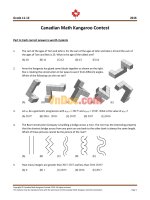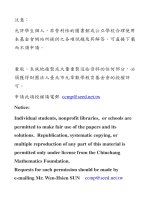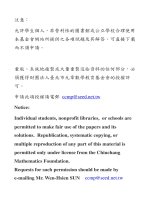Đề thi Toán quốc tế COMC năm 2018
Bạn đang xem bản rút gọn của tài liệu. Xem và tải ngay bản đầy đủ của tài liệu tại đây (786.81 KB, 21 trang )
<span class='text_page_counter'>(1)</span><div class='page_container' data-page=1>
2018 Canadian Open Mathematics Challenge
</div>
<span class='text_page_counter'>(2)</span><div class='page_container' data-page=2>
Question A1 (4 points)
NO PHOTOCOPIES!Supposex is a real number such thatx(x+ 3) = 154. Determine the value of (x+ 1)(x+ 2).
Your solution:
Your final answer:
Question A2 (4 points)
Letv, w, x, y, and z be five distinct integers such that 45 =v×w×x×y×z. What is the
sum of the integers?
Your solution:
</div>
<span class='text_page_counter'>(3)</span><div class='page_container' data-page=3>
Question A3 (4 points)
NO PHOTOCOPIES!Points (0,0) and (3√7,7√3) are the endpoints of a diameter of circle Γ. Determine the other
x intercept of Γ.
Your final answer:
Question A4 (4 points)
In the sequence of positive integers, starting with 2018,121,16, ...each term is the square of
the sum of digits of the previous term. What is the 2018th term of the sequence?
Your solution:
</div>
<span class='text_page_counter'>(4)</span><div class='page_container' data-page=4>
Question B1 (6 points)
NO PHOTOCOPIES!Let (1 +√2)5 <sub>=</sub><sub>a</sub><sub>+</sub><sub>b</sub>√<sub>2, where</sub><sub>a</sub> <sub>and</sub> <sub>b</sub> <sub>are positive integers. Determine the value of</sub> <sub>a</sub><sub>+</sub><sub>b</sub><sub>.</sub>
Your solution:
</div>
<span class='text_page_counter'>(5)</span><div class='page_container' data-page=5>
Question B2 (6 points)
NO PHOTOCOPIES!Let ABCD be a square with side length 1. Points X and Y are on sides BC and CD
respectively such that the areas of triangles ABX, XCY, and Y DA are equal. Find the
ratio of the area of ∆AXY to the area of ∆XCY.
Your solution:
Your final answer:
A
B C
</div>
<span class='text_page_counter'>(6)</span><div class='page_container' data-page=6>
Question B3 (6 points)
NO PHOTOCOPIES!The doubling sum function is defined by
D(a, n) =
nterms
z }| {
a+ 2a+ 4a+ 8a+. . . .
For example, we have
D(5,3) = 5 + 10 + 20 = 35
and
D(11,5) = 11 + 22 + 44 + 88 + 176 = 341.
Determine the smallest positive integer n such that for every integer i between 1 and 6,
inclusive, there exists a positive integer ai such that D(ai, i) =n.
Your solution:
</div>
<span class='text_page_counter'>(7)</span><div class='page_container' data-page=7>
Question B4 (6 points)
NO PHOTOCOPIES!Determine the number of 5-tuples of integers (x1, x2, x3, x4, x5) such that
(a) xi ≥i for 1≤i≤5;
(b)
5
X
i=1
xi = 25.
Your solution:
</div>
<span class='text_page_counter'>(8)</span><div class='page_container' data-page=8>
Question C1 (10 points)
NO PHOTOCOPIES!At Math-ee<sub>-Mart, cans of cat food are arranged in an pentagonal</sub>
pyramid of 15 layers high, with 1 can in the top layer, 5 cans in
the second layer, 12 cans in the third layer, 22 cans in the fourth
layer etc, so that thekth <sub>layer is a pentagon with</sub> <sub>k</sub> <sub>cans on each</sub>
side.
(a) How many cans are on the bottom, 15th<sub>, layer of this </sub>
pyra-mid?
(b) The pentagonal pyramid is rearranged into a prism
con-sisting of 15 identical layers. How many cans are on the
bottom layer of the prism?
(c) A triangular prism consist of identical layers, each of which
has a shape of a triangle. (The number of cans in a
trian-gular layer is one of the triantrian-gular numbers: 1,3,6,10,...)
For example, a prism could be composed of the following
layers:
top view
front view
n = 1
n = 2
n = 3
n = 4
Prove that a pentagonal pyramid of cans with any number of layers l ≥ 2 can be
rearranged (without a deficit or leftover) into a triangular prism of cans with the same
number of layers l.
</div>
<span class='text_page_counter'>(9)</span><div class='page_container' data-page=9></div>
<span class='text_page_counter'>(10)</span><div class='page_container' data-page=10></div>
<span class='text_page_counter'>(11)</span><div class='page_container' data-page=11>
Question C2 (10 points)
NO PHOTOCOPIES!Alice has two boxes A and B. Initially box A contains n coins and box B is empty. On
each turn, she may either move a coin from boxA to box B, or removek coins from boxA,
where k is the current number of coins in box B. She wins when box A is empty.
(a) If initially box A contains 6 coins, show that Alice can win in 4 turns.
(b) If initially box A contains 31 coins, show that Alice cannot win in 10 turns.
(c) What is the minimum number of turns needed for Alice to win if boxAinitially contains
2018 coins?
</div>
<span class='text_page_counter'>(12)</span><div class='page_container' data-page=12></div>
<span class='text_page_counter'>(13)</span><div class='page_container' data-page=13></div>
<span class='text_page_counter'>(14)</span><div class='page_container' data-page=14>
Question C3 (10 points)
NO PHOTOCOPIES!Consider a convex quadrilateral ABCD. Let rays BA and CD intersect at E, rays DA
and CB intersect at F, and the diagonals AC and BD intersect at G. It is given that the
triangles DBF and DBE have the same area.
(a) Prove thatEF and BD are parallel.
(b) Prove thatG is the midpoint of BD.
(c) Given that the area of triangle ABD is 4 and the area of triangle CBD is 6, compute
the area of triangle EF G.
</div>
<span class='text_page_counter'>(15)</span><div class='page_container' data-page=15></div>
<span class='text_page_counter'>(16)</span><div class='page_container' data-page=16></div>
<span class='text_page_counter'>(17)</span><div class='page_container' data-page=17>
Question C4 (10 points)
NO PHOTOCOPIES!Given a positive integer N, Matt writesN in decimal on a blackboard, without writing any
of the leading 0s. Every minute he takes two consecutive digits, erases them, and replaces
them with the last digit of their product. Any leading zeroes created this way are also erased.
He repeats this process for as long as he likes. We call the positive integerM obtainablefrom
N if starting from N, there is a finite sequence of moves that Matt can make to produce the
number M. For example, 10 is obtainable from 251023 via
251023→25106→106 →10
(a) Show that 2018 is obtainable from 2567777899.
(b) Find two positive integers A and B for which there is no positive integerC such that
bothA and B are obtainable fromC.
(c) Let S be any finite set of positive integers, none of which contains the digit 5 in its
decimal representation. Prove that there exists a positive integer N for which all
elements of S are obtainable from N.
</div>
<span class='text_page_counter'>(18)</span><div class='page_container' data-page=18></div>
<span class='text_page_counter'>(19)</span><div class='page_container' data-page=19></div>
<span class='text_page_counter'>(20)</span><div class='page_container' data-page=20>
Premier Sponsors
in association with
Sponsors:
Aqueduct
Banff International
Research Station
Centre de recherche
math´ematiques
The Fields Institute
Maplesoft
The McLean Foundation
Popular Book Company
RBC Foundation
S.M. Blair Foundation
The Samuel Beatty Fund
Academic Partners:
University of British Columbia
University of Calgary
Dalhousie University
University of Manitoba
Memorial University
University of New Brunswick
University of Prince Edward Island
Dept. of Mathematics & Statistics,
(University of Saskatchewan)
University of Toronto
York University
ASDAN China
Government Partners:
Alberta Education
Manitoba
New Brunswick
Northwest Territories
Nova Scotia
Nunavut
Ontario
</div>
<span class='text_page_counter'>(21)</span><div class='page_container' data-page=21>
<i><b>The 2018 Canadian Open</b></i>
<i><b>Mathematics Challenge</b></i>
<i><b>November 8/9, 2018</b></i>
<i><b>STUDENT INSTRUCTIONS</b></i>
<b>General Instructions:</b>
<b>1)</b> Do not open the exam booklet until instructed to do so by your proctor
(supervising teacher).
<b>2) Before the exam time starts, the proctor will give you a few minutes to</b>
<b>fill in the Participant Identification on the cover page of the exam.</b>You
don’t need to rush. Be sure to fill in all required information fields and
write legibly.
<b>3) Readability counts:</b>Make sure the pencil(s) you use are dark enough to
be clearly legible throughout your exam solutions.
<b>4)</b> Once you have completed the exam and given it to the proctor/teacher
you may leave the room.
<b>5)</b> The questions and solutions of the COMC exam must not be publicly discussed or shared (including
online) for at least 24 hours.
<b>Exam Format:</b>
There are three parts to the COMC to be completed in a total of 2 hours and 30 minutes:
<b>PART A:</b> Four introductory questions worth 4 marks each. You do not have to show your work. A
correct final answer gives full marks. However, if your final answer is incorrect and you have
shown your work in the space provided, you might earn partial marks.
<b>PART B:</b> Four more challenging questions worth 6 marks each. Marking and partial marks follow the
same rule as part A.
<b>PART C:</b> Four long-form proof problems worth 10 marks each. Complete work must be shown. Partial
marks may be awarded.
Diagrams provided are<i>not</i>drawn to scale; they are intended as aids only.
<b>Scrap paper/extra pages:</b>You<i>may</i>use scrap paper, but you have to throw it away when you finish
your work and hand in your booklet. Only the work you do on the pages provided in the booklet will
be evaluated for marking. Extra pages are not permitted to be inserted in your booklet.
<b>Exact solutions:</b>It is expected that all calculations and answers will be expressed as exact numbers
such as 4π, 2 + √7, etc., rather than as 12.566, 4.646, etc.
</div>
<!--links-->









